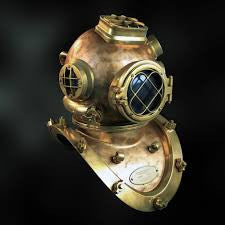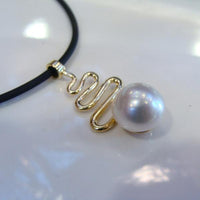Pearls and their shells were first ‘discovered’ at Nickol Bay in the Pilbara of Western Australia in 1861. Settlers like John Withnell, who was a pastoralist collected up to six tonnes of pearl shell per day at the mouth of the De Grey River to supplement his income. By the early 1880s, attention was focused on Broome and it's rich shell beds at Eighty Mile Beach.

In 1881, boats began arriving in Broome, bringing with them diving suits, bronze helmets, lead boots and diving apparatus. Peering out through thick glass, the divers collected as much shell as possible on each dive, as they were paid by the amount of shell collected.

With the new diving helmets, divers were able to now reach the deeper shell off the Lacepede Islands and Eighty Mile Beach, doubling the daily catch of fifty-seven skin divers (commonly called this because they dived without the aid of googles or a snorkel and naked!)
The town of Broome was gazetted in 1883, named after Frederick Napier Broome, the Governor of Western Australia, who was beyond horrified at his name being given to the scruffy assortment of pearling camps lining the bay.
Although the shell brought rewards, diving was dangerous in the waters of the Kimberley whereby the divers faced cyclones, sharks, crocodiles, beriberi, ear and chest infections and the bends. For most of the first twenty years, the crew were predominantly Aboriginal skin divers, with up to 57 divers on any one boat.
The success of the Broome pearling industry hinged on the size of the Broome pearl oyster, Pinctada maxima, which was large enough to supply mother-of-pearl for cutlery handles, buttons and buckles and used as inlay for furniture. Natural pearls were rare and extremely valuable, and when found, were placed in a locked box on the lugger.
By 1914 Broome was supplying 80% of the world’s pearl shell and there was over 400 luggers and 3,500 people involved in the industry. At its peak, pearl shell was worth £400 per tonne.
The small wooden luggers went to sea on the neap tides and had no cooking facilities or toilets. The crew lived in cramped conditions, with piles of stinking pearl shell on the decks. Each diver had a tender (short for attender) who stayed on the surface to oversee the dive.

The township of Broome was thriving and had a cosmopolitan population made up of Chinese, Japanese, Sri Lankans, West Australians (mainly Aborigines), Torres Strait Islanders, Manilamen and Filipinos from the Phillipines, Malays from Malaysia, Rotumah men from Roti, Koepangers from Timor, and Amboinese from the Moluccas who were all there to be involved in the pearling industry.
Under the WA Pearling Act of 1913, only British citizens were allowed to own pearl luggers and a rigid class system was the result, with the Japanese, working as the divers, the Malays and Koepangers working as the deckhands and crew.
Eventually the Japanese made up the majority of people working on the lugger, working as indentured labour. Almost all of the Japanese divers came from the city of Taiji, now a sister city to Broome. Many of the Japanese struggled to pay off their debts, often their passage to Australia. The largest of the immigrant groups was the Chinese, who worked as pearlers, cooks and shopkeepers.
The adoption of the White Australia Policy in the early 20th century led to the government recruiting twelve British navy divers, most of whom perished. As as a result, Broome received an exemption from the policy. During the two world wars production almost ceased, and when Japan entered the war, most of the Japanese were interned in prisoner of war camps.
By the 1950s, with the development of plastic buttons, the pearl shell industry fell into a decline. The first pearl farm in the Kimberley was established at Kuri Bay, in Camden Sound, 370km north of Broome, in 1956.

Kuri Bay, named after Mr Tokuichi Kuribayashi, was a joint venture between the Japanese, Americans and Australians, following the repeal of the Pearling Act.
By 1973, Kuri Bay was producing 60% of the world’s large, south sea pearls.
Since 2008 the world market has been flooded with freshwater cultured pearls and once again, pearl shell has become a staple of the pearling industry.





